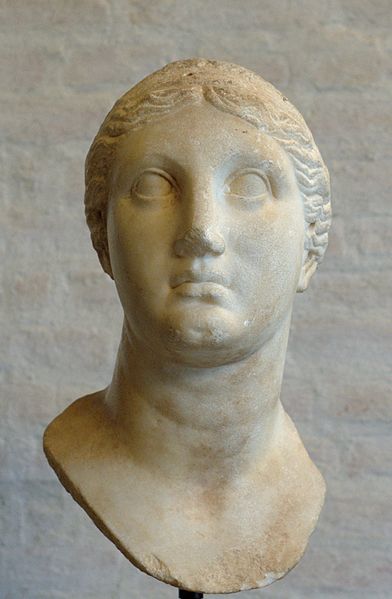Berenice II de Egipto
De Wikipedia, la enciclopedia libre
Berenice II (h. 269 a. C. — 221 a. C.) era hija del rey Magas de Cirene y de Apama, hija de Antíoco I Sóter. Su matrimonio con Ptolomeo III Evergetes, tercer gobernante de la Dinastía Ptolemaica del Antiguo Egipto, posibilitó la re-anexión de Cirene a Egipto.
Apama, partidaria de una alianza con la dinastía seléucida de Siria, intentó frustar dicho matrimonio prometiendo a Berenice con el príncipe macedonio Demetrio el Bello, pero ella urdió un plan para asesinarlo, tras lo cual casó con Ptolomeo III.
Tuvo cuatro hijos con él: el futuro Ptolomeo IV, Arsínoe III, Magas, y Berenice, esta última muerta en su infancia.
Tras la muerte de su esposo en 221 a. C., su hijo Ptolomeo (probablemente asociado al trono junto a ella) la mandó envenenar, temiendo que pretendiera nombrar sucesor a su hermano Magas.
Estando ya incluida en el culto dinástico junto a su esposo con el nombre de Los EvergetesBenefactores), a su muerte Ptolomeo creó en su honor un sacerdocio anual, el Athlophoros. (
Berenice II fue además la primera reina del Egipto ptolemaico que hizo acuñar monedas con su efigie.
El cabello de Berenice [editar]
Cuando Ptolomeo subió al trono, su primera misión consistió en ir a Siria para luchar contra el rey Seleuco II y vengar el asesinato de su hermana y de su sobrino (que era el heredero al trono de esta región de Asia). Combatió largamente y obtuvo muchas victorias, pero en su ausencia, su esposa Berenice languidecía y estaba llena de temores por la vida de su esposo. En su desconsuelo, un día fue al templo de Afrodita y allí juró ante la diosa que sacrificaría para ella su hermosa cabellera (que era la admiración de todos cuantos la conocían), en el caso en que Evergetes regresara vivo y vencedor. Así fue, y ese mismo día, el día de su regreso, Berenice cumplió su promesa.
Pero por la noche alguien llegó hasta el templo y robó la cabellera. Se rumoreó que lo hizo un sacerdote del templo de Serapis, dios egipcio, indignado por el hecho de que la reina hiciera un sacrificio a una deidad griega. La desesperación de Berenice y el furor de Ptolomeo ante el hecho del hurto fueron grandes. Pero ante ellos llegó el astrónomo Conón de Samos para calmarlos. Su ciencia era muy venerada; había escrito siete libros sobre astronomía y todo el mundo conocía su gran amistad con el famoso Arquímedes de Siracusa. Conón mostró a los reyes una agrupación de estrellas, y les contó que esa constelación acababa de aparecer en el firmamento y que sin duda se trataba de la cabellera de Berenice, que había sido transportada allí por la diosa Afrodita, a quien se le había ofrecido. Después, el sabio Conón dibujó una larga melena de estrellas en el globo celeste del Museo de Alejandría.
El poeta y gramático griego, Calímaco de Cirene, que había sido bibliotecario de la Biblioteca de Alejandría durante muchos años, inmortalizó a la reina Berenice y su magnífica cabellera en una elegía. He aquí uno de sus fragmentos:
.
Titulatura [editar]
| Titulatura | Jeroglífico | Transliteración (transcripción) - traducción - (procedencia) |
| Nombre: |
| brnygt (Bernyget)
Berenice |
| Nombre: |
| birnygt (Birnyget)
Berenice |
Enlaces externos [editar]
 Wikimedia Commons alberga contenido multimedia sobre Berenice II de Egipto.
Wikimedia Commons alberga contenido multimedia sobre Berenice II de Egipto.
Berenice II
From Wikipedia, the free encyclopedia
Berenice II (267 or 266 BC - 221 BC), was the daughter of Magas of Cyrene and Queen Apama, and the wife of Ptolemy III Euergetes I, the third ruler of the Ptolemaic dynasty of Egypt.
In about 249 BC, she was married to Demetrius the Fair, a Macedonian prince, soon after her father died. However after coming to Cyrene he became the lover of her mother Apama. In a dramatic event, she had him killed in Apama's bedroom, but Apama lived on afterwards. This happened around 248 or 247 BC. She had no children with Demetrius.
Afterwards she married Ptolemy III. They had at least 4 children: Ptolemy IV, Magas, Arsinoe III and Berenice. She was murdered by Ptolemy IV in 221, soon after he became pharaoh.
During her husband's absence on an expedition to Syria, she dedicated her hair to AphroditeZephyrium. The hair having by some unknown means disappeared, Conon of Samos, explained the phenomenon in courtly phrase, by saying that it had been carried to the heavens and placed among the stars. This story is parodied in Alexander Pope's The Rape of the Lock. for his safe return, and placed it in the temple of the goddess at
The name Coma Berenices or Berenice's hair, applied to a constellation, commemorates this incident. Callimachus celebrated the transformation in a poem, of which only a few lines remain, but there is a fine translation of it by Catullus. Soon after her husband's death (221 BC) she was murdered at the instigation of her son Ptolemy IV, with whom she was probably associated in the government.
The predecessor of the modern city Benghazi was refounded by her and received her name: Berenice.
The asteroid 653 Berenike, discovered in 1907, is also named after Queen Berenice.
[edit] References
- This article incorporates text from the Encyclopædia Britannica, Eleventh Edition, a publication now in the public domain.
[edit] References
| Wikimedia Commons has media related to: Berenice II |
- Salmonson, Jessica Amanda.(1991) The Encyclopedia of Amazons. Paragon House. Page 33. ISBN 1-55778-420-5
- The House of Ptolemy, Ch. 3
- Berenice II
En otros idiomas
- Беларуская
- Català
- Deutsch
- Ελληνικά
- English
- Suomi
- Français
- Magyar
- Italiano
- 日本語
- Nederlands
- Norsk (bokmål)
- Polski
- Português
- Русский
- Srpskohrvatski / Српскохрватски
- Svenska
- 中文
| | Fotos de
|
Egipto










 " alt=">" height="44px">
" alt=">" height="44px">



No hay comentarios:
Publicar un comentario